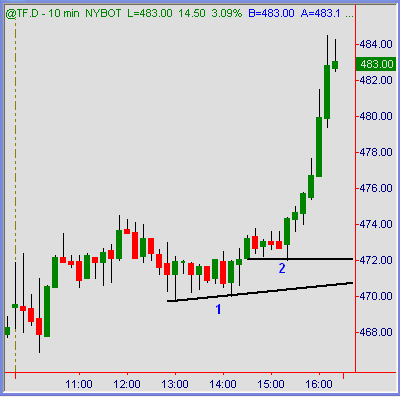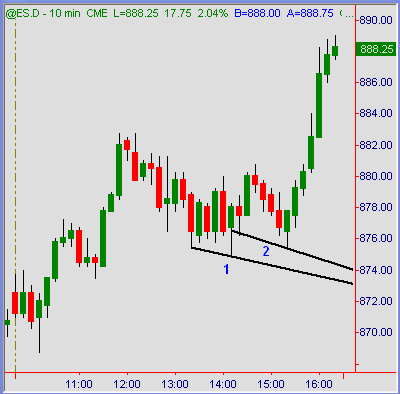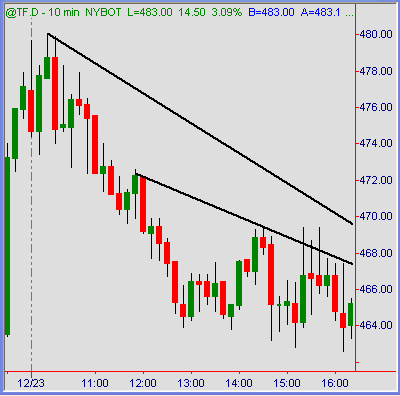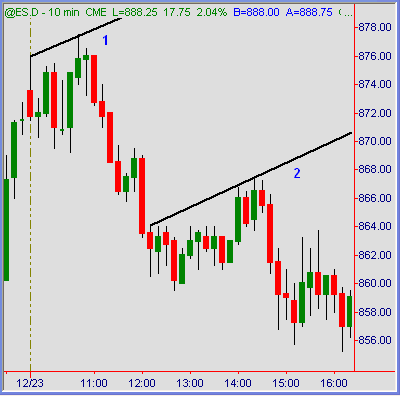What I Trade When S&P Volatility Dips
We’ve said this before: mention the word “futures” and many trader’s immediate thoughts run to daytrading and index e-mini markets. No doubt they’re most popular with daytraders in particular, and index futures markets are obviously amongst the most heavily traded of all. But that doesn’t make them the only viable choice, and in many cases not even the best choice for most traders.
InGrained
When discussing futures markets other than e-mini index symbols to trade, imo grain futures, specifically corn (ZC) and soybean (ZS) contracts have to rank right up near the top. Let’s list a few key features that place them in that category.
#1: Electronic contracts traded through CME. Enough said
#2: Liquid. Bid/ask spreads of $12.50 per tick are one and in some cases two ticks wide apart from brief high-volatility bursts. In most cases during the trading day you will see 10 to 20 contracts clearing through time & sales with no change in price or one-tick difference on the fills. That includes both corn and soybean contracts alike. The hourly run-rate average for ZC and ZS contracts is pretty even with YM and TF e-mini index futures. Plenty liquid enough for individual retail traders.
#3: Margins. Intraday traders have the same minimal margin requirements through most futures brokers on grain futures contracts that e-mini index futures have. No difference there for outright long or short positions held intraday. Traders that opt to take their operation one step beyond directional long/short only and evolve into the world of spread trading (ala market makers) will never find better markets for that. A number of intra-market and inter-market spreads are available to trade as one position with greatly reduced overnight margin rates than outright long or short. Being “hedged” in a position long one grain and short another makes the chance for lock-limit overnight losses muted or nil. Again, that is one or two steps beyond merely buying or selling the market for directional plays, but something to consider for down the road if desired.
#4: Hours of operation. Open outcry (pit session) hours are 10:30am through 2:15pm EST or a mere 3.75 hours of trading. Pretty much all of the volume and most of the price movement happens inside this window of time. Occasionally there are some wide overnight swings, but for the most part price movement is confined to that pit-session stretch.
Compare that to currencies, crude oil and stock indexes which can and often do make large-range moves all through the night. Grain futures have a known period of concentrated action to schedule for. Marathon-chair sessions watching screens flicker sideways around the clock while waiting for something to go somewhere is not part of the equation here.
Chart 1

#5: Price movement. Grain futures are not (as of yet) dominated by algorithm computer-programs that arbitrage or high-frequency-trade price action to death. Part of the current low-range problem with e-mini index futures is a large percentage of daily volume is computer bots playing push & shove with one another. Grain futures enjoy more natural, unfettered price movement that translates into oscillations and swings. Intraday trend moves are noticeably straighter and smoother in grains than stock index markets comparatively.
Soybean futures swing high at 1061 (cents per bushel) to lows near 1032 (cents per bushel) was a 29-cent (ES index point equivalent) trend move lower. At $50 per one-cent move, the actual dollar range per ZS contract was $1,450 through that 3.75 hour pit session.
Chart 2

#6: E-mini crossover language. For traders well-versed with e-mini index futures reluctant to learn another “language”, good news. Grain futures translate the same. Soybeans and Corn trade in $50 per one-cent price moves, minimum price fluctuation is 1/4 cent or $12.50 per tick. That is exactly the same as ES $50 per one index-point move and $12.50 per 1/4 point tick. No change in language whatsoever… interchange the term “points” for “cents” and resulting math is identical.
Corn futures in the chart example above from 413 (cents per bushel) high to 404 (cents per bushel) low was a nine-cent range lower. That is identical to a nine-point ES futures range through three hour’s time. One difference would be the smoothness and deliberation of price in that range descent. You won’t see many ES charts looking that technically pure…
Chart 3

#7: … which is a direct result of nil computer-bot arbitrage domination. Corn and soybean grain futures trade technically pure. Chart patterns form and play out as expected more often than not. Points of support and resistance are honored well, often to the exact tick before sharp reaction = reversals. Breakouts work well. Pullbacks work well. Everything based on technical analysis works better in grains than almost any other market, because most (not all) of the price action there is based on accumulation or distribution. Sideways arbitrage or micro-scalping computer strategies don’t shove the tapes sideways all day. Hence, price moves up or down in rather rhythmic fashion.
Chart 4

#8: At the time of this writing, a transaction tax on financial trades is being widely touted. That is said to include stocks, bonds and all of their derivative markets related as such. But nowhere in that proposal do we see commodity futures markets listed. I’ve been told by futures brokers that in their opinion an inclusion of all commodity markets, aka consumable goods being taxed is not likely. It’s one thing for the powers that be to sway public opinion on a plan to curb short-term trading and its (supposed) adverse affect on their IRAs and 401k plans. It is quite another sales pitch to tell actual consumers of the goods being taxed that higher prices as a result have benefits.
Joe & Jane Average are not happy with the stock market and their returns from such. They are easily convinced that curbing (perceived) detrimental activity through some type of taxation is a win-win situation. They are even less happy with the rising cost of foods and consumable goods. Any type of tax proposal on raw (commodity) goods that may impact consumer price one iota will be met with completely different attitudes.
If any markets do become taxed out of short-term trading existence (doubtful) it would be stock index futures first, commodity grain futures last. Food for thought… pun intended.
Summation
Many traders are weary of the low-volume, low volatility e-mini index markets of late. A lot more traders would like to diversify capital across low correlated futures markets to maximize profit opportunity and/or smooth out equity curve performance. Of all the various futures markets available to trade, I personally cannot think of any that would be better than CME traded grain contract futures. For the reasons listed above and more, everyone deserves to give them more than a cursory consideration to trade.
Austin Passamonte is a full-time professional trader who specializes in all commodity markets. Mr. Passamonte’s trading approach uses proprietary chart patterns found on an intraday basis. Austin trades privately in the Finger Lakes region of New York. Click here to visit CoiledMarkets
